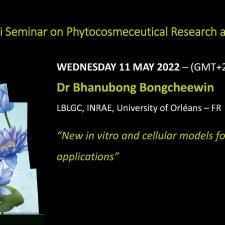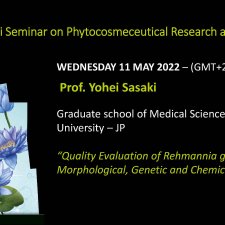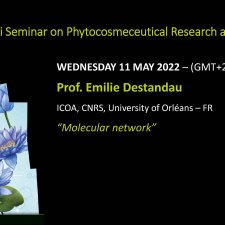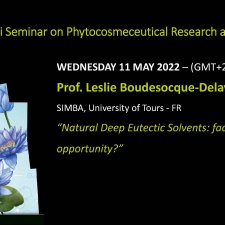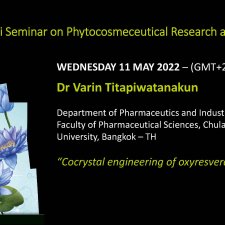Notice
Dr Ruhainee Tohkayomatee - Green extraction of Thai medicinal plants
- document 1 document 2 document 3
- niveau 1 niveau 2 niveau 3
Descriptif
Extraction is a major step to separate bioactive compounds from raw material and medicinal plants, which extracted by the pharmaceutical industry, either with conventional methods or modern technologies. The conventional methods such as maceration, reflux and Soxhlet extraction, which usually uses of organic solvents such as methanol, ethyl acetate, dichloromethane and others. Nevertheless, the organic solvents are problematic in the extraction of bioactive compounds from the herbal plant because of their toxicity, volatility and flammability. Moreover, some methods use high energy consumption and the large amount of solvents, and may have lower extraction efficiencies. Thus, the separation of bioactive compounds in industrial scale for pharmaceutical and cosmetic applications, green and efficient extraction process that are free toxic solvents is being emphasized. Nowadays, green extraction methods have been developed for the extraction of bioactive compounds from herbal plants including ultrasound-assisted extraction (UAE), microwave-assisted extraction (MAE), etc. The advantages of both UAE and MAE methods are using shorter extraction time and lower temperature, and decreased the amount of solvent required. Recently, many medicinal plants use green extraction to separate biological active compounds such as extraction of rhinacanthin-C from Rinacanthus nasutus (R. nasutus) with MAE method by comparison with the conventional extraction method including maceration (Shakya K, 2015). The MAE significantly increased rhinacanthin-C content and markedly reduced the extraction time when compared to the maceration method (Shakya K, 2015). The extraction of Thai traditional medicinal extract, U-pa-ri-waat (URW) using MAE and traditional solvent extraction was compared based on the percent yield and determined antioxidant activity (Jaisamut P, 2021). Comparing the two extraction methods, MAE provided an extract yield similar to the water decoction, while MAE method had a tenfold decrease in extraction time when compared to the traditional method. Moreover, both MAE and tradition decoction methods for URW have been shown to have effective antioxidant activity. Other example, Thai herbal formula Kleeb Bua Daeng (KBD) was extracted with UAE and MAE methods. KBD was extracted with MAE method had higher yield, total phenolic content, total flavonoid content, total carotenoid content, and total anthocyanin content than UAE method and MAE appeared to be an efficient extraction method for this Thai herbal formula (Ngamkhae N, 2022). In conclusion, the green extraction methods were fast and reduced the amount of solvent for efficient extraction of total bioactive compounds from medicinal plants. Recent findings of green extraction method could potentially be used to develop herbal formulations with higher content and efficiency of active compounds.
Thème
Dans la même collection
-
Dr Arnaud Lanoue - Agricultural by-products valorization
Winemaking generates different biomolecule-rich byproducts, including pomaces (skin and seeds), lees, as well as other solid wastes like grape canes.
-
Dr Bhanubong Bongcheewin - The Mint family (Lamiaceae) in Thailand- A potential material source for…
Lamiaceae is the large family, consisting of more than 7,000 species worldwide
-
Prof. Yohei Sasaki - Quality Evaluation of Rehmannia glutinosa by Morphological, Genetic and Chemic…
Previously, the medicinal plant, Rehmannia glutinosa, is grouped into two types in Japan. However, previous reports of genetic analysis of R. glutinosa in commercial products suggest the existence of
-
Prof. Emilie Destandau - Molecular network
Specialised metabolites constitute a high valuable resource of bio-active compounds that are highly sought after for pharmaceutic and cosmetic applications. However, plant extracts are very complex
-
Prof. Leslie Boudesocque-Delaye - Natural Deep Eutectic Solvents: fad or real opportunity?
NaDES appeared at the end of the 2010s following the work of Dai et al. Since then, the enthusiasm for these new green solvents linked to ionic liquids has continued to grow.
-
Dr Varin Titapiwatanakun - Cocrystal engineering of oxyresveratrol
Oxyresveratrol (ORV) is a compound found in the heartwood of Artocarpus lakoocha Roxburgh (Moraceae). It has diverse biological and therapeutic activities covering antioxidant, anti-inflammatory,


